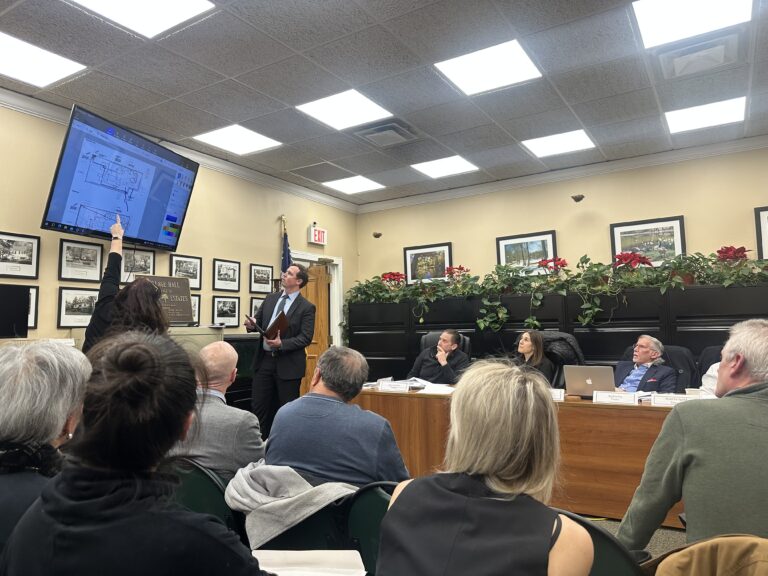
Roslyn Estates residents continued to push back against new cellular antennas in the village Monday night, questioning the safety of the antennas for those living in the the neighborhood.
“They’re not our friends here,” resident Jennifer Cherney said. “They’re going to do what they’re legally allowed to do under the law, which is put up more antennas.”
Dish Wireless cellphone service is proposing to install wireless communications equipment on top of the building at 1044 Northern Blvd. This building already houses cellphone antennas for three other cellphone service providers.
”It’s really in the public’s benefit to have a fourth carrier to control the market and not allow the other carriers to run rampant with charges and fees,” Daniel Patrick, the attorney representing Dish, said.
While the village continued its public hearing on the matter Monday night, the board opted to carry over the discussions to its February meeting. The village has not made a decision on whether or not to grant the permit to Dish.
Dish’s permit proposal to install new antennas in the village has drawn pushback from residents throughout the process who have advocated against approval of the permit.
Patrick said the company had changed its plans since the public hearing began in November to address concerns posed by the village.
These modifications include moving equipment to make it less visible from the south side of the building, which is where residential homes are located, and further towards the middle or Northern Boulevard side.
Dish is proposing three sets of two antennas, with two located on the northeast corner and one on the southeast.
Patrick said due to its being a new provider with fewer funds and resources than other carriers, Dish seeks to locate its telecommunications equipment on existing facilities – as evident in their request in Roslyn Estates.
Patrick said Dish’s equipment will not extend the height of the building as the antennas will be lower than some of the antennas already existing on top.
“We believe that this meets the village’s goal of co-location,” Patrick said. “We’re not proposing anything out of the ordinary or out of the context for that area.”
Cherney argued that the additions of Dish’s equipment would substantially modify the building, potentially allowing the village to deny the application.
The village’s attorney, Christopher Prior, previously said that the village’s ability to fight this permit is limited as the federal government has “eroded” local governments’ abilities to prevent the installation of telecommunications equipment over the decades.
He also said that while aesthetics is an argument that can prevent the installation, this objection has been weakened for the village due to the already existing equipment atop the building.
With the addition of the fourth carrier atop the building, Dish estimates that the radiation emissions from the facility will increase from 58.8% to 59.8%, a 1% increase. Patrick called this increase minimal and still within the threshold of safety as determined by the FCC.
Marc Harris, the FCC compliance engineer for Pinnacle Telecom Group, said the increase is small because of different frequencies, wattages and down tilts. While the increase is small, Harris said it is an overestimation of what emissions would be at its maximum usage.
Harris assured residents that Dish’s emissions are within the FCC standards and “very, very safe.”
Michelle Bounaix, who lives within 75 feet of the facility, said that based on reports she gathered from other surrounding telecommunication facilities, Roslyn Estate’s is much higher in its emissions.
“This is somewhere I live,” Bounaix said. “And for these numbers to be so exponentially higher than all the other towers that you have reported for, I’d like to know how you feel comfortable reporting this and being able to look at me right now and say ‘I would live here myself.’”
Harris said the differences in emissions could be attributed to the heights of the facilities, with a greater height contributing to lower emissions at street level.
The residents also questioned why the emissions rate was taken at the street level when residents’ homes nearby rise above the street level and individuals work within the building housing the equipment.
Harris said the antennas are directional, meaning they do not emit below into the building, and that he has never seen emissions greater than 10% through buildings with such equipment.
He said emissions were calculated at the ground level because they provide information the community is seeking.
“We’re trying to be good neighbors,” Harris said.
Harris assured residents that Dish’s calculations for its additional equipment are within full compliance with the FCC’s regulations.
Bounaix said there were also discrepancies between the number of antennas Dish said are on top of the building and how many the village has permitted, citing three additional antennas from AT&T not permitted by the village.
Dan Powers, a representative from Dish, said Dish went on top of the building to assess the equipment there, assuring that their map with the additional, unpermitted antennas is accurate.
Jacob Turner, an attorney representing residents opposing Dish’s antennas, argued that Dish has not met its burden to be granted the permit.
He said that if the village approves this permit, an Article 78 lawsuit against actions taken by a municipality will be filed against them.
“So the question is: What do you want to do?” Turner said. “The answer is: Hold their feet to the fire…otherwise, we’ll see you in Supreme Court.”






